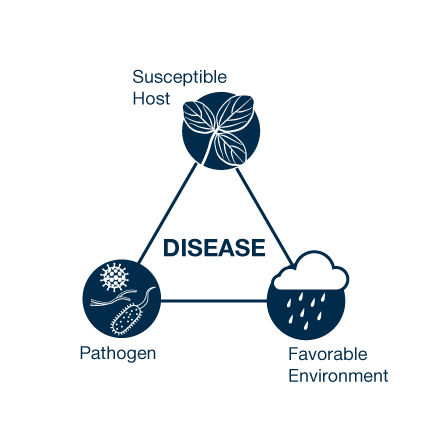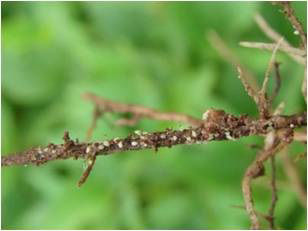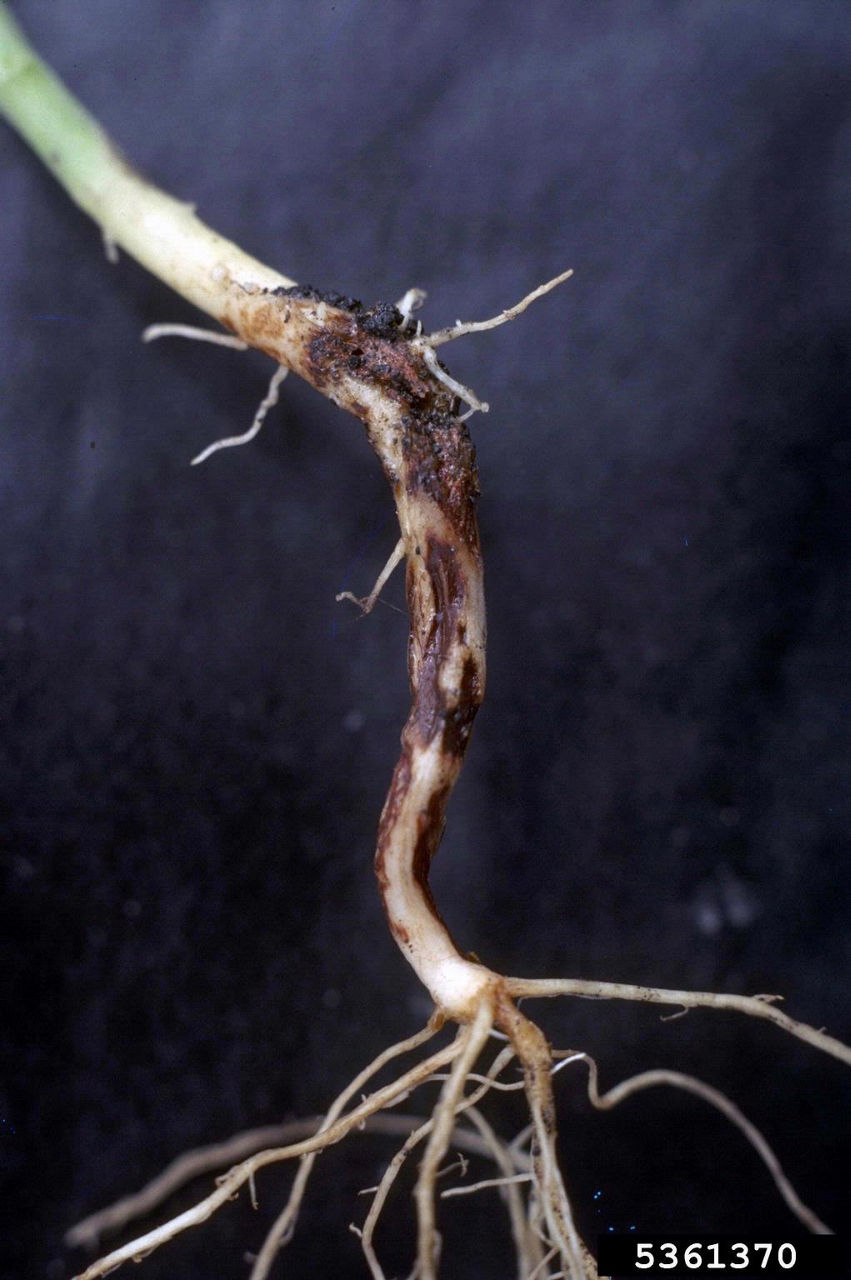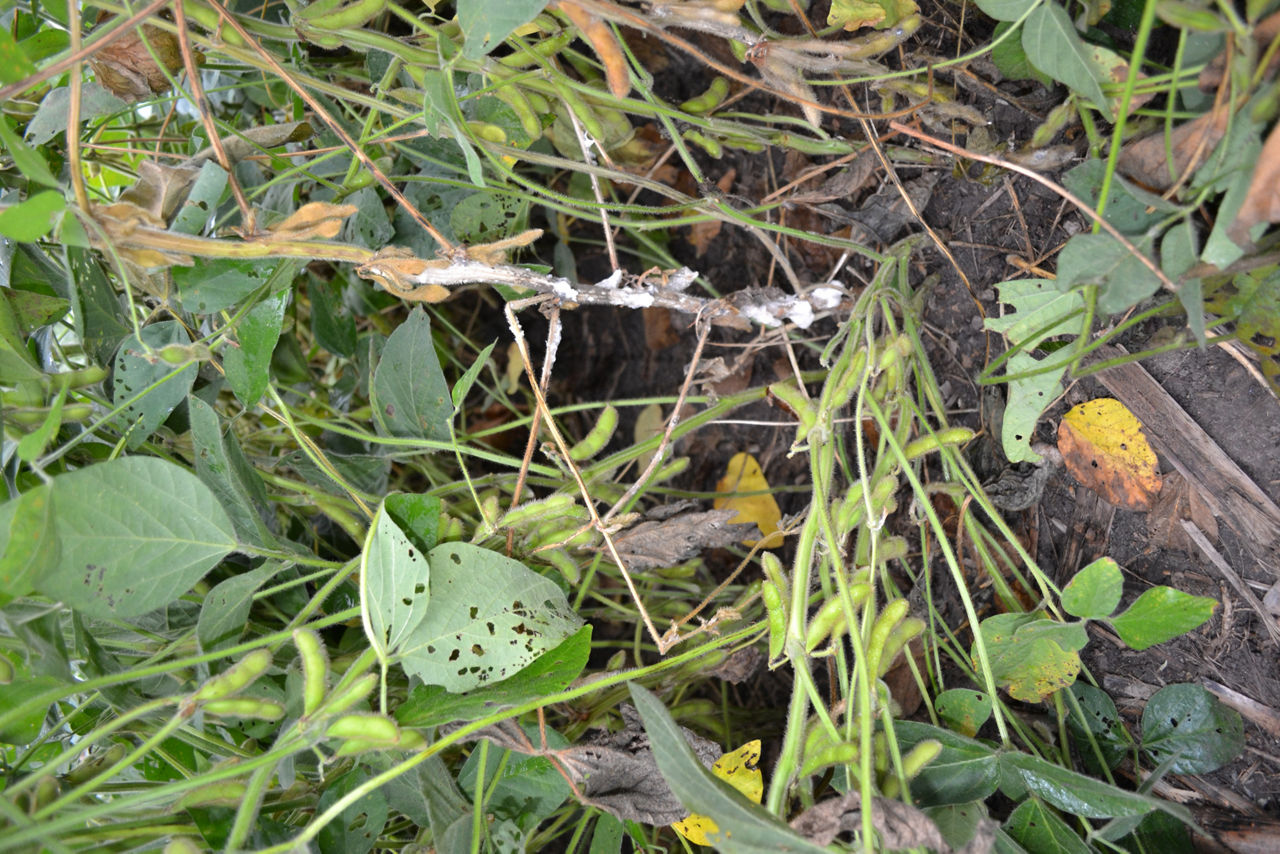10 MIN READ
Managing Soybean Disease
May 25, 2023
- Soybean diseases can be caused by many microorganisms (including fungi, bacteria, viruses, and nematodes) that can damage soybean plants, reducing vigor and yield potential.
- All growth stages can be attacked, from the seed to mature plants.
- Plants under stressed growing conditions, such as from drought, excessive moisture, extreme temperatures, chemical injury, or other physical injuries, are often more susceptible to disease.
- Disease symptoms vary depending on the pathogen, and symptoms may also be influenced by soybean product, growing conditions, or physical injuries.
The three components necessary for disease to occur are a susceptible host plant, the presence of a pathogen, and an environment conducive for disease. This is represented by the disease triangle (Figure 1).

Management
Preventative measures, such as altering the planting date, planting resistant cultivars, and crop rotation can help reduce disease levels and lower the impact of disease. Responsive measures are used when field observations or laboratory testing have indicated the presence of a pathogen, for example, detection of soybean cyst nematode (SCN) through soil testing or a known history of sudden death syndrome or white mold.
There are several preventative and responsive tools that can be used to help manage diseases in the field. Determining the most effective approach depends on the disease, crop history of the field, the growing conditions, and accurate diagnosis of the disease(s) present. Several factors have contributed to an increased incidence and severity of some soybean diseases in recent years. Systems using no-till or reduced tillage practices have increased the amount of crop residue present in the field. These residues may harbor pathogens that can infect plants in future growing season. Shorter rotations can also allow for the populations of some types of pathogens to persist or increase in the field.
In some cases, pathogens have adapted to resistance genes available in commercial soybean products or to chemicals, such as fungicides, rendering these control methods less effective. Disease management should include the use of several methods to help reduce disease pressure and protect the efficacy of resistance genes, fungicides, and nematicides.
Scouting
Proper identification of the causal agent begins with regular scouting for disease. Depending on the disease, diseases can be patchy or have a different distribution pattern within a field. Scouting should be conducted in a pattern that covers a wide variety of field locations, such as a M or W configuration, to increase the likelihood of intercepting an area of diseased plants. If an area in the field is a perennial disease problem, scouting that area first may help determine the proper timing of early disease management strategies, such as fungicide applications. Field biomass maps like those generated by Climate FieldView™ digital insights or using agricultural drones can help identify areas of concern and increase scouting efficiency.
Soybean Product Selection
Select soybean products with the appropriate resistance genes and/or best tolerance when there is a known risk of a disease. Products with resistance can exhibit little to no disease symptoms even when environmental conditions are favorable for disease development. However, resistance can be overcome by high inoculum levels or favorable conditions. There are two types of resistance incorporated into commercial soybean products: (1) race-specific resistance and (2) partial resistance. These two types may have differences in the field, but both can be effective in limiting losses due to soybean pathogens.
Race-specific resistance is effective against some strains (races) of the pathogen but not others, while other forms of resistance are more general and equally effective against all strains of a particular pathogen. Some forms of resistance provide near immunity to a disease, resulting in little or no symptom development, while other resistance genes convey partial resistance in which disease does develop but at a slower rate or with less severe symptoms, resulting in fewer effects on production when compared to a completely susceptible plant.
Crop Rotation
A good crop rotation program is essential for long-term productivity. Wheat and corn in a crop rotation scheme are beneficial for reducing some pathogen populations. Without the presence of soybean plants, many soybean pathogen populations begin to decline. Soybean cyst nematode (Figure 2) populations are reduced by half in the first few years that corn or wheat are grown. Crop rotation is not effective against diseases that do not overwinter in the field but are brought in on air currents (powdery mildew) or by insects (soybean mosaic). Crop rotation will also not reduce populations of pathogens that are soil inhabitants or have long-term resting structures that allow the pathogen to survive for long periods (many years) in the absence of a soybean crop (Rhizoctonia root rot).

Seed Treatments
In most soybean production areas, the weather is highly variable from year to year. Seed treatments can help protect the seed and young seedlings from numerous pathogens that infect soybeans at planting and early emergence, such as Phytophthora (Figure 3) or Rhizoctonia (Figure 4), especially during cool, wet periods when germination and seedling growth are delayed.


Figure 4. Rhizoctonia root rot. Image courtesy of Howard F. Schwartz, Bugwood.
Tillage
Tillage can be an effective management tool under the following conditions:
- High incidence of residue-borne pathogens,
- Wet years after losses due to Phytophthora or other root rot organisms, or
- Heavy crop debris on the soil surface, causing the soil to retain moisture and stay cooler for longer periods in the spring.
Row Width and Seeding Rate
Narrow row widths and high seeding rates can help decrease time to canopy closure and increase light interception. However, it is important to consider disease pressure when determining the seeding rate and row width. White mold (Figure 5) is one of the greatest concerns in the northern soybean production area. It favors a cool, overcast, wet environment. Cold and cloudy conditions in combination with high rainfall during flowering also contribute to an increased chance of infection. A dense soybean canopy increases humidity and limits air movement creating an ideal environment for the white mold fungus. In fields with a history of white mold, growers are encouraged to lower the seeding rate and consider a wider row spacing, along with selecting soybean products with resistance to white mold, and if necessary, apply fungicides active against white mold.

Planting Date
In recent years, higher soybean yields have been correlated to earlier planting dates. Improved genetics and planting systems have contributed to earlier planting dates. The ideal soil temperature for soybean germination is 77 °F. For most of the Midwest, soil temperatures do not reach these levels at a soil depth of two inches until mid to late May. Soybeans can germinate at soil temperatures as low as 50 °F at two inches, but it can take up to three weeks for emergence at these low temperatures. It is recommended to plant soybeans when soil conditions are suitable, and not into wet or cold soils early in the planting season. Planting into a field that is too wet early in the season can result in reduced yields at the end of the year.
Cold soils slow root development and make the stand more susceptible to root rot pathogens. Use of a fungicide seed treatment is highly recommended if there is a field history of diseases caused by species of Phytophthora, Pythium, Rhizoctonia, or Fusarium.
Seeding Rates
In most areas a seeding rate of 140,000 seeds/acre is recommended if using a row crop planter. Plant populations of 100,000 plants/acre that are evenly spaced at harvest is recommended. Seeding rates may range from 120,000 plants/acre up to 160,000 plants/acre depending on soil conditions, environment, historical stand establishment, management level, weed control, and disease management. Consult your local extension service and soybean product supplier for specific seeding rate recommendations for your area.
Field Disease History
Keeping a record of when a disease has occurred, and specifically, how widespread and how severe a disease was in a certain field can be critical for determining how to manage for a disease. Records should be easily accessible and may be recorded and organized using an app or other means. Many universities have free apps available to record and save various field conditions. Regardless of what method is used, recording disease occurrence data is highly important in being prepared to make a decision based on field history.
Soil Testing for Soybean Cyst Nematode
There are several species of plant pathogenic nematodes which feed on soybean, including lance, sting, lesion, root-knot, and soybean cyst nematode (SCN). Of these, SCN causes the greatest yield losses in soybean. In plants affected by SCN, water and nutrient uptake by the root is impaired, and the number of nitrogen-producing nodules formed on the roots is reduced. When above-ground symptoms are visible, plants look yellow and stunted. SCN may be present in a soybean field without causing any above-ground symptoms but still reduce soybean yields. Soybean cyst can go unnoticed for several years. When visible symptoms are present, yield loss can be as high as 50%.1
Recent SCN surveys indicate that a high percentage of fields previously planted to soybeans have some level of SCN infestation. The best way to diagnose and quantify SCN levels in a field is by collecting soil samples and sending them to a professional diagnostic laboratory. If available, use a soil probe to a depth of 8 inches to collect each sample. If soybeans were grown the year of the sample, collect samples within the row, in the root zone. Check with your local extension service for potential testing programs, specific sampling methods, and where the closest diagnostic lab is located.
Most soybean seed companies have specific types of SCN resistance listed in their seed catalogs. Knowing the nematode species present and the HG types (races) of SCN present is important when selecting a resistant soybean product.
Sources:
1 Thiessen, L. and Gorny, A. 2022. Disease and nematode management North Carolina State Extension. North Carolina Soybean Production Guide. AG-835. https://content.ces.ncsu.edu/north-carolina-soybean-production-guide/soybean-disease-and-nematode-management/.
2 Allen, T. 2012. Principles of plant pathology: The disease triangle and influence of the environment. Mississippi State University Extension. https://www.mississippi-crops.com/2012/08/31/the-principles-of-plant-pathology-the-disease-triangle-and-influence-of-the-environment/.
3 Singh, M. 2022. Soybean planting considerations: Planting date, seeding rate and row spacing implications. Michigan State University. https://www.canr.msu.edu/news/soybean-planting-considerations-planting-date-seeding-rate-and-row-spacing-implications#:~:text=Soybean%20row%20spacing%20used%20by,)%2069%25%20of%20the%20time.
More information
Mueller, D. et. al. 2016. A Farmer’s Guide to Soybean Diseases. American Phytopathological Society Press.
1311_68751